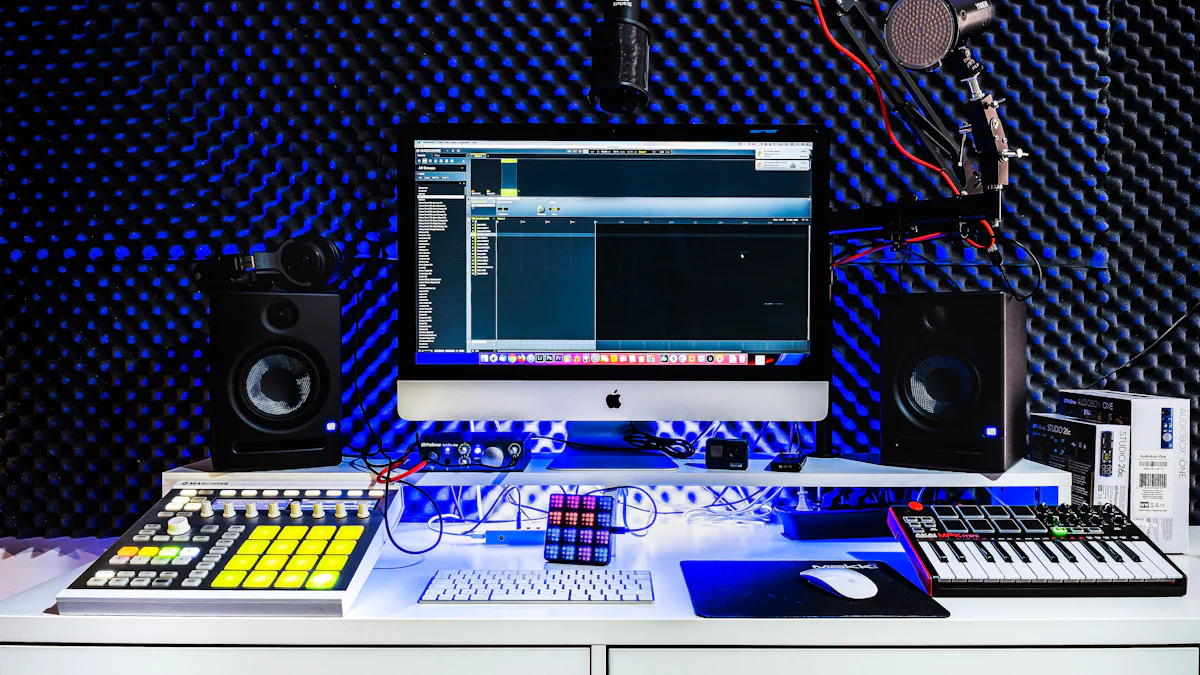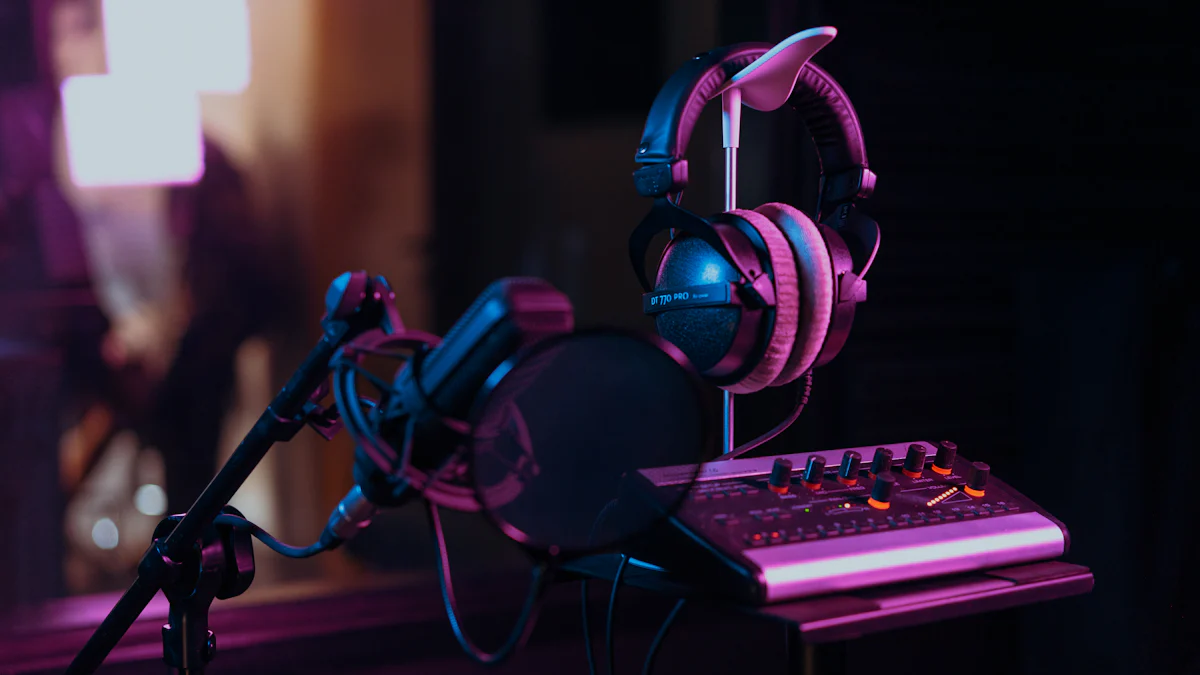Top Equipment Tips for Professional Sound on Zoom

In today's digital world, Zoom meetings have become a staple for communication. You might not realize it, but professional sound quality can make or break your virtual interactions. Good audio doesn't just help you sound clear; it boosts your credibility and professionalism. Studies show that people trust what they hear when the sound quality is high. Poor audio, on the other hand, can lead to misunderstandings and disengagement. So, if you're wondering how to sound professional on Zoom calls, focusing on your audio setup is a great place to start.
Key Takeaways
- Invest in a dedicated USB microphone to enhance clarity and volume, making your voice stand out during Zoom calls.
- Optimize your microphone settings by adjusting input levels and testing sound quality to ensure clear audio.
- Position your microphone 6 to 12 inches away from your mouth and keep it unobstructed for the best sound capture.
- Use headphones to minimize echo and feedback, improving the overall audio experience for you and your audience.
- Choose a quiet environment for your calls and consider noise-canceling software to reduce background distractions.
- Regularly maintain your equipment by cleaning microphones and updating software to ensure consistent audio quality.
- Experiment with different setups and equipment to find what works best for you, enhancing your virtual communication.
How to Sound Professional on Zoom Calls with High-Quality Microphones

When it comes to Zoom meetings, your voice should be as clear as your message. Using a dedicated microphone can make a world of difference. Let's dive into why this is a game-changer and explore some top picks for USB microphones.
Benefits of Using a Dedicated Microphone
Enhanced Clarity and Volume
A dedicated microphone boosts your voice's clarity and volume. Unlike built-in laptop mics, these devices capture sound more accurately. You won't have to shout or repeat yourself. Your audience will hear you loud and clear, making your communication more effective.
Reduction of Background Noise
Background noise can be a real distraction during calls. A good microphone helps reduce this issue. Many models come with noise-canceling features. These features filter out unwanted sounds, so your voice remains the focus. This is crucial for maintaining professionalism in your meetings.
Recommended USB Microphones
Choosing the right microphone depends on your budget and needs. Here are some options to consider:
Budget-Friendly Options
If you're looking for something affordable, the Blue Microphones iCE Snowball is a great choice. It's known for its quality at a low price. Another option is the Moman EMP, which offers high-quality sound for under $50. Both are excellent for those starting out.
Mid-Range Choices
For those willing to spend a bit more, the Amazon Basics Desktop Mini Condenser Microphone and the Shure MV5 are solid picks. Priced around $60 and $100 respectively, they provide a balance of quality and affordability. These microphones are perfect for users who want reliable performance without breaking the bank.
High-End Picks
If you're aiming for studio-grade sound, consider the Audio-Technica AT2020USB+ or the Blue Yeti. The Audio-Technica model is highly sensitive and offers exceptional audio fidelity. Meanwhile, the Blue Yeti is a favorite among professionals for its versatility and superior sound quality. Both are investments that pay off in crystal-clear audio.
By selecting the right microphone, you can significantly improve how you sound on Zoom calls. Whether you're on a budget or ready to splurge, there's a microphone out there that fits your needs. Remember, sounding professional starts with the right equipment.
Optimizing Microphone Settings for Professional Sound
Getting the best sound on your Zoom calls isn't just about having a great microphone. You also need to know how to set it up properly. Let's explore some techniques to optimize your microphone settings and ensure you sound professional.
Calibration Techniques
Proper calibration is key to achieving clear and professional audio. Here are some steps to help you get started:
Adjusting Input Levels
First, you need to adjust your microphone's input levels. This step ensures your voice comes through clearly without distortion. Open your computer's sound settings and find the input level controls. Start by speaking at a normal volume and watch the input meter. Aim for the levels to hover around the middle of the range. If the levels peak into the red zone, lower the input to prevent distortion. This simple adjustment can make a big difference in how you sound.
Testing Sound Quality
Once you've set the input levels, it's time to test the sound quality. Record a short clip of yourself speaking and listen back. Pay attention to clarity and volume. If you notice any issues, tweak the settings and test again. This process helps you identify the best configuration for your setup. Remember, testing is crucial for finding out how to sound professional on Zoom calls.
Ideal Microphone Positioning
Where you place your microphone can greatly impact your audio quality. Let's look at some tips for ideal positioning:
Distance from Mouth
The distance between your mouth and the microphone affects how you sound. Keep the microphone about 6 to 12 inches away from your mouth. This range captures your voice clearly without picking up too much background noise. Too close, and you might sound muffled; too far, and your voice may become faint. Finding the sweet spot is essential for professional sound.
Avoiding Obstructions
Make sure nothing blocks your microphone. Objects like papers or your hand can obstruct sound waves, leading to muffled audio. Keep your workspace tidy and ensure the microphone has a clear path to your mouth. This simple step can enhance your audio quality significantly.
By following these tips, you can optimize your microphone settings and improve your Zoom call experience. Whether you're adjusting input levels or positioning your microphone, each step brings you closer to sounding professional. Remember, practice makes perfect, so don't hesitate to experiment with different setups.
Addressing Common Audio Issues on Zoom
Even with the best equipment, you might still face audio issues during Zoom calls. Let's tackle some common problems and explore solutions to ensure you sound professional on Zoom calls.
Solutions for Echo Problems
Echoes can disrupt your meetings and make communication difficult. Here are some ways to address this issue:
Using Headphones
Headphones or earphones can significantly reduce echo and feedback. By using them, you prevent your microphone from picking up sounds from your speakers. This simple change can enhance your audio quality and keep your conversations clear.
Adjusting Zoom Settings
Zoom offers several audio settings that can help manage echo. Go to the audio settings and enable the "Suppress Persistent Background Noise" and "Suppress Intermittent Background Noise" options. These settings help minimize unwanted sounds, including echoes, ensuring a smoother meeting experience.
Minimizing Background Noise
Background noise can be distracting and unprofessional. Here are some strategies to minimize it:
Noise-Canceling Software
Consider using noise-canceling software to filter out ambient sounds. Tools like Krisp or RTX Voice can effectively reduce background noise, allowing your voice to stand out. These applications work well with Zoom and can make a noticeable difference in your audio quality.
Choosing a Quiet Environment
Selecting a quiet environment for your Zoom calls is crucial. Find a space away from noisy appliances or busy streets. If possible, inform others in your household about your meeting schedule to minimize interruptions. A quiet setting helps maintain professionalism and ensures your message is heard clearly.
Ensuring a Stable Internet Connection
A stable internet connection is vital for maintaining good audio quality. Here's how you can ensure your connection is reliable:
Wired vs. Wireless Connections
Whenever possible, use a wired connection instead of Wi-Fi. Ethernet cables provide a more stable and faster connection, reducing the chances of audio dropouts. If a wired connection isn't feasible, position yourself close to your router to improve Wi-Fi stability.
Checking Bandwidth
Before your meeting, check your internet speed to ensure it meets Zoom's requirements. Websites like Speedtest can help you measure your bandwidth. If your speed is low, consider pausing other internet activities or upgrading your plan. A stable connection ensures your audio remains clear and uninterrupted.
By addressing these common audio issues, you can improve your Zoom call experience. Whether you're dealing with echoes, background noise, or connection problems, these solutions will help you sound professional on Zoom calls. Remember, small adjustments can lead to significant improvements in your audio quality.
Practical Tips for Maintaining Audio Quality in Various Environments

Maintaining top-notch audio quality on Zoom calls requires adapting to different environments and ensuring your equipment is in peak condition. Let's explore how you can achieve this.
Adapting to Different Environments
Your environment plays a crucial role in how you sound during Zoom calls. Whether you're in a home office or on the go, here are some tips to help you maintain professional audio quality.
Home Office Setup
Creating an ideal home office setup can significantly enhance your audio experience. Start by choosing a quiet room where you can minimize interruptions. Use soft furnishings like curtains and carpets to absorb sound and reduce echo. Position your microphone away from noisy devices like fans or air conditioners. This setup helps you maintain a clear and professional sound, making it easier for others to understand you.
On-the-Go Solutions
When you're on the move, maintaining good audio quality can be challenging. Portable microphones or headsets with noise-canceling features are excellent choices. They help filter out background noise, ensuring your voice remains the focus. Consider using a mobile hotspot for a stable internet connection if you're in an area with unreliable Wi-Fi. These solutions ensure you sound professional, no matter where you are.
Regular Equipment Maintenance
Keeping your audio equipment in good condition is essential for consistent performance. Here are some maintenance tips to help you get the most out of your gear.
Cleaning Microphones
Regularly cleaning your microphone prevents dust and debris from affecting its performance. Use a soft brush or compressed air to remove particles from the microphone grille. Avoid using liquids, as they can damage the internal components. Clean equipment ensures your microphone captures sound accurately, helping you maintain a professional tone on Zoom calls.
Updating Software
Software updates often include improvements that enhance audio quality. Regularly check for updates to your operating system, Zoom app, and any audio software you use. These updates can fix bugs, improve compatibility, and introduce new features that enhance your audio experience. Staying up-to-date ensures you always have the best tools at your disposal.
By adapting to different environments and maintaining your equipment, you can consistently achieve high-quality audio on Zoom calls. Whether you're setting up a home office or traveling, these tips will help you sound professional and make a lasting impression.
Achieving professional sound on Zoom calls boils down to a few key steps. First, invest in a high-quality microphone and set it up correctly. This simple change can drastically improve your audio clarity. Next, optimize your microphone settings and position it well. These adjustments ensure your voice comes through clearly. Finally, address common audio issues like echoes and background noise.
"The best way to improve the audio quality on Zoom calls is to use a high-quality microphone and set it up properly."
Don't hesitate to experiment with different equipment and settings. Finding what works best for you can make all the difference in your virtual interactions.
FAQ
What type of microphone should I use for Zoom calls?
You should use a dedicated USB microphone for the best sound quality on Zoom calls. These microphones offer enhanced clarity and volume compared to built-in laptop mics. Depending on your budget, you can choose from budget-friendly options like the Blue Microphones iCE Snowball, mid-range choices like the Shure MV5, or high-end picks like the Audio-Technica AT2020USB+.
How do I reduce background noise during my Zoom meetings?
To reduce background noise, use a microphone with noise-canceling features. You can also activate noise suppression in Zoom's audio settings. Additionally, consider using noise-canceling software like Krisp or RTX Voice. Choosing a quiet environment for your calls will also help minimize distractions.
Why is my voice echoing on Zoom, and how can I fix it?
Echoes usually occur when your microphone picks up sounds from your speakers. To fix this, use headphones or earphones. You can also adjust Zoom's audio settings by enabling "Suppress Persistent Background Noise" and "Suppress Intermittent Background Noise" to help manage echoes.
How can I ensure my internet connection is stable for Zoom calls?
For a stable connection, use a wired Ethernet connection instead of Wi-Fi whenever possible. If you must use Wi-Fi, position yourself close to the router. Check your internet speed before meetings using websites like Speedtest. If your speed is low, pause other internet activities or consider upgrading your plan.
What is the ideal microphone positioning for clear audio?
Place your microphone about 6 to 12 inches away from your mouth. This distance captures your voice clearly without picking up too much background noise. Ensure nothing obstructs the microphone, like papers or your hand, to avoid muffled audio.
How often should I clean my microphone?
Clean your microphone regularly to prevent dust and debris from affecting its performance. Use a soft brush or compressed air to remove particles from the microphone grille. Avoid using liquids, as they can damage the internal components.
Can I use Bluetooth audio equipment for Zoom calls?
Bluetooth audio equipment offers flexibility, but wired connections often provide better sound quality. If you choose Bluetooth, ensure your device is fully charged and within range to avoid connectivity issues.
How do I test my microphone settings before a Zoom call?
Test your microphone settings by recording a short clip of yourself speaking. Listen back to check for clarity and volume. Adjust the input levels if necessary and test again until you achieve the desired sound quality.
What should I do if my audio quality suddenly drops during a call?
If your audio quality drops, check your internet connection first. Ensure your microphone is properly connected and positioned. Restart Zoom or your computer if the issue persists. Regularly updating your software can also prevent unexpected audio problems.
How can I maintain professional audio quality while traveling?
When traveling, use portable microphones or headsets with noise-canceling features. These devices help filter out background noise. Consider using a mobile hotspot for a stable internet connection if you're in an area with unreliable Wi-Fi.
See Also
Tips for Effectively Managing Your Hybrid Zoom Gatherings
Comprehensive Zoom Guide: Everything You Need to Know
Enhance Your Virtual Meetings with 12 Creative Zoom Backgrounds
Step-by-Step Guide to Perfecting Your Computer Audio Visual Skills
